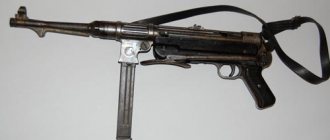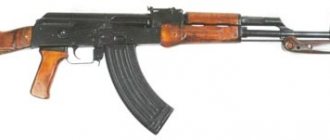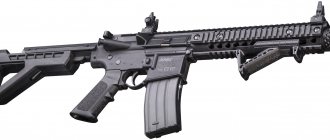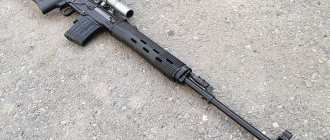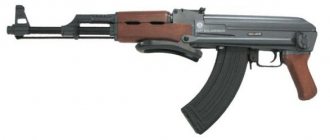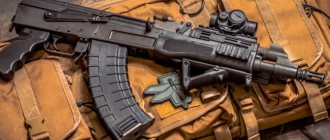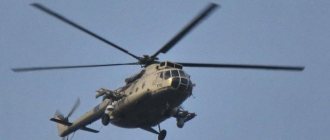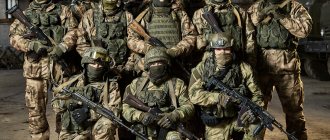The new AK-19 is an assault rifle in NATO caliber - 5.56 millimeters. It was presented at the Army 2020 forum in August 2022. Unique features of the development were the new rear sight and telescopic stock, the ergonomic properties of which were fundamentally improved. The machine is also equipped with a slotted flame arrester, which allows for quick installation of a muffler. The predecessor of the AK-19 is the AK-12, its version for the civilian market was called AK TR3. Initially, it was positioned as a platform for new solutions for military and civilian purposes. A new solution has been released, and now we can compare the two models to evaluate the fundamental differences between the latter.
The AK-12 caliber is 5.45 mm, it was created as part of the Ratnik program and presented to the world in 2012. Soon after its appearance, many rumors appeared that a new Kalashnikov would appear, already chambered for NATO. And this year the rumors were confirmed.
Familiar store
Mass production of the 5.45 mm AK-12 assault rifle began in 2022. Outwardly it looks like the classic Kalashnikov, but in fact the army received a new rifle system. Major changes were made to the design of the machine. Thanks to this, he was able to fire in fixed bursts with a cutoff of two shots. The manufacturer also increased the survivability of the barrel, for the production of which they began to use new technology.
“Rook” to “Alligator” comrade: The Southern Military District will receive new equipment
Attack helicopters and attack aircraft are sent to potential conflict zones
For the SuperKalashnikov, additional removable muzzle devices were also developed and the convenience of switching firing modes was increased. New thermal imagers, silencers and collimator sights are produced for it, which allow precise fire at head targets at a distance of up to 500 m. As a result, the AK-12 received increased accuracy when firing, but at the same time retained the reliability of all mechanisms, which it has always been famous for “ Kalashnikovs."
The machine gun received Picatinny rails - universal brackets mounted on the weapon. They allow you to quickly and without technical modifications change sights, tactical flashlights and laser designators, install a front handle or bipod for more accurate shooting from stationary positions.
The level of unification of the new AK-12 with the basic AK-74M model was about 54%, which made it possible to quickly and at minimal cost begin mass production. Also, the AK-12 can be equipped with standard GP-25 and GP-30 under-barrel grenade launchers - they have been in service with the army for a long time.
Together with the AK-12, you can use standard AK-74 magazines with a capacity of 30 rounds. The new magazine for the AK-12 now has transparent slots, with which you can see how many rounds are in it - 30, 20, 10 or even less. This allows you to properly control the fire.
How savings ruined the new Kalashnikov AK-12 assault rifle
The updated Kalash began to enter the troops. But how different is it from previous models? The gunsmiths promised to introduce a bolt stop mechanism, a magazine release button and a four-position fire switch. All of the above is absent in the “new” machine. Our soldiers will continue to use obsolete weapons. Why is this happening?
Subject: Weapons, Army
Created in the mid-40s and first put into production in 1949, the Kalashnikov assault rifle, often erroneously called the AK-47
, was a worthy example of weapons for its time. A design that is simple to the point of genius, ensuring the viability of the machine gun in almost any weather, climatic and extreme conditions, and equally simple controls that make it possible in the shortest possible time to train, if not a monkey, then any soldier, from privates of the Soviet Army to some partisans, to shoot from a machine gun African republic. Cheap production. And, in general, good combat characteristics - all this provided the Kalashnikov assault rifle with well-deserved fame, which over time turned into a worldwide semi-legendary status.
The problems started later. While foreign systems, which initially did not have the opportunity to boast the same “reliability” and ease of maintenance ( for example, with the first American assault rifles that took part in the Vietnam War, always included a whole set of tools necessary for disassembling, cleaning and assembling the weapon. To disassemble and clean the AK, it was enough to have not very crooked fingers and the ability to remember the sequence of simple actions
), over time improved, refined, got rid of their shortcomings and acquired new advantages. Picatinny rails appeared, magazines that were not so sensitive to contamination, ways to reduce recoil were constantly being developed (here it should be noted that our domestic designers also conducted research in this area, working on the so-called balanced automation. For example, Stanislav Koksharov).
But the Kalashnikov assault rifle seemed to be stuck in time. Years passed, but the base, the basis of the machine remained identical to the one from 1949. Yes, over time, wood was replaced with plastic, the muzzle brake-compensator was changed, a different main ammunition was adopted... But the backbone, the skeleton of the machine gun remained the same until the second decade of the 21st century. Photos for comparison:
photo from world.guns.ru
First AK
, manufactured in 1949.
photo from world.guns.ru
AK-74M
, a model that is still considered the main weapon of both regular troops and special forces of the Russian Federation.
photo from world.guns.ru
AK-103
, a model of the modern “hundredth series”, supplied both for export and for service with the Special Forces of the Russian Federation.
On this topic
1145
A drunk anesthesiologist opened fire in a hospital in the Stavropol region
According to eyewitnesses, anesthesiologist Andrei Miroshnichenko wanted to arrange a showdown with his wife, who works in a hospital in Svetlograd. The doctor had a Kalashnikov assault rifle with him.
No matter how great the external difference between the new models and the model of the forties may be, this is a deceptive impression - at its core, it is still the same “Kalash” of 1949.
There was only one argument, and at first it even seemed convincing - “ why break a bicycle if it works?”
" Indeed, until recently it seemed that since the AK remained reliable and unpretentious, there was nothing to improve - it shoots, does not break, and is cheaper than some fruits. What else is needed?
This was believed until the first comparative tests of the convenience and comfort of handling weapons were carried out. Tests that AK
lost miserably.
Morally obsolete
There is no point in going into the rationale for the need for a standard ergonomic handle, modular design, and so on - suffice it to say that when comparing the speed of tactical reloading ( tactical reloading is a method of reloading a weapon, achieved through long training and ensuring the fastest possible change from an empty magazine to a full one, incl. hours with loading the cartridge into the chamber
) the best
AK
reaches plus or minus three seconds.
2.87
,
3.02
... The direct, main competitor of the AK - a weapon on the
AR
(
which will be discussed below
) gave a result of
1.18
seconds (!). Need I say that when one of the soldiers reloads his weapon one and a half, or even two seconds earlier than the other, then the second soldier, taking into account the same professional training of both, is almost guaranteed to be doomed?
Here's another example. Its purity is ensured by the fact that in the presented video there is a problem with the ergonomics of the AK
This was experienced not by an ordinary soldier of the motorized rifle troops, but by a special forces soldier. Take a look at this video, the excerpt you are interested in starts at
1:28
:
The soldier on the left attempted to reload his weapon for six seconds. Comments, as they say, are unnecessary. Let us repeat - the fighter in the video is a professionally trained fighter, most likely with many years of experience. Here the reason lies in the angle of the magazine insertion, in other words, in the unfortunate features of the old AK
.
But in fact, the need to modernize Kalash has been brewing for a long time. In fact, from the moment the first Armalite
(
AR weapon system
) – popularly referred to by the general term “
Emka
”, “
M-16
”.
Control schemes used in American ARKs, namely a convenient fire switch-fuse located on both sides, a well-placed magazine eject button, which allows you to simultaneously get rid of the spent one and get a new source of ammunition from unloading, and, of course, the bolt stop ( a system that allows send a cartridge from a new magazine with one quick movement of your free hand
), unfortunately, they were ahead of not only the Kalashnikov assault rifle of the 1949 model, but also models that would be released later, much later than the first M-oks - both the
AK-74
and
AK -103
, and...
AK-12
.
Expectations vs. reality
AK family were demonstrated to both the military and the general public
, finally, more than 60 years after the release of their first ancestor, they truly resembled weapons that had evolved and caught up with their foreign competitors.
For once, the Kalashnikov assault rifle has replaced the annoying, inconvenient, bulky, loudly clicking, and, importantly, fire mode translator. Instead, the good old four-position switch appeared, also located on both sides of the weapon. The bolt handle also received a twin sister on the left side of the rifle, which automatically solved the problem of the inability to control the weapon with one hand. After so many years of waiting, the bolt stop finally appeared. Despite some minor details and questions, everyone stated that the AK
finally really received a strong impetus for development.
On this topic
2544
From the Caribbean to Europe - in which ports did the yachts of Russian billionaires moor before the New Year?
The most expensive yachts of members of the Russian list of the richest businessmen moored in different world ports during the New Year period. Apparently, not all Russian billionaires prefer hot countries.
Alas, after a very short time, namely in 2016, the fairy tale began to turn into the harsh everyday life of the Russian “increasing profitability.”
Here is a photo of one of the latest versions of the same AK-12
, to simplify the design.
photo by Konstantin Lazarev
photo by Konstantin Lazarev
All the elements and design solutions that marked the evolutionary development of the classical Kalashnikov system are visible. A convenient four-position fire mode switch is a safety switch located on both sides of the weapon and controlled by the thumb of the hand located on the handle of the machine gun, without the need to remove your hand from it. A more convenient magazine release lever, as well as the long-awaited reset button. A bolt handle that can be moved to the left side. The presence of a shutter stop function, which is so necessary for quick and convenient reloading.
This is the final version of the AK-12
2016.
photo from the official website of the Kalashnikov Concern
photo from the official website of the Kalashnikov Concern
Old fire mode switch. Old magazine release lever ( even on the first AK-12 prototypes there was an improved version. Here it is equivalent to the 1949 AK version
). The bolt handle cannot be moved to the left side. Missing slide stop.
However, there are changes. Technically, this is still the same Kalashnikov assault rifle of the 1949 version. AK-12
(
now having a new name AK-15/16
) has the same automatic gas release with locking by turning the bolt.
However, burst shooting with a two-round cut-off has been added. A so-called “floated forend” has been added, which does not touch the barrel and increases the stability of the weapon when firing. The receiver cover is secured in such a way that the influence of “backlash” ( “shaking” of moving parts when firing
) is leveled out.
Yes, there are changes. Are they needed to modernize and improve a weapons system that is almost seventy years old? Of course. Are they enough to call the AK-12
a truly new assault rifle? Of course not.
The “body kit”, represented by such details as a telescopic butt and Picatinny rails, cannot be seriously considered as a weapon development, since such an “improvement” can be made by absolutely anyone who owns an AK platform weapon and the money to buy the necessary accessories, not like a weapons company -billionaire. What was the reason for such degradation of the seemingly promising new Kalashnikov?
A fighter's life is cheaper than a new machine gun
Here we encounter continuity. In the seventies AK
could already lose to another weapon system - according to test results, an assault rifle for a new caliber, the
SA-006
Konstantinov
system .
The SA-006 was superior to the AK in almost everything. Accuracy, accuracy, firing efficiency, and with all this – similar reliability. The competition commission of the Soviet Army recognized the AK as the winner, citing the reason for the “design that has been worked out and mastered by industry and the troops.” And also... AK
was recognized as cheaper to produce.
That's the whole scheme. The weapons don't have to be better. It should be conservative and cheap. The same story befell the new, essentially ahead of its time, 6.5 Grendel
. Its development was put to an end, formulated by the question “what should we do with warehouses filled with 7.62 and 5.45 cartridges?” The reasonable answers “sell” and “export” were ignored...
Concern " Kalashnikov"
“, in principle, did not hide this sad continuity: his employees openly said that in order to implement, for example, a bolt stop, it would be necessary to create new stores, which would entail large expenses for the state. budget. The same applies to the magazine reset button - a design change is required.
Essentially an AK-12
differs little from the Kalash of the so-called 200 series, which were designated as “a
simple body kit for the good old AK-74M
.”
By the way, in 2014, on December 9, the general director of the Kalashnikov concern, Alexei Krivoruchko,
indicated the estimated cost of the AK-12 - it, according to him, was about
one thousand dollars
.
At that time, the dollar exchange rate was already about 60 rubles. This cost, even taking into account inflation, is not much different from the cost of a comprehensive AK body kit from Zenit
and
Allmulticam
. A simple, we repeat, body kit. Consisting of purchasing parts and installing them on, say, an AK-74M.
Talk about the presence of balanced automation, which was proposed even for the not so old AK-107
and
AK-108
, and there is no point at all - it was not even planned initially.
You need to be objective, work on the development of the AK-15/16
continue to be carried out.
For example, an employee of the Kalashnikov concern, in a conversation with the author of the article, confirmed that work on the fire mode translator continues, and over time it will be replaced with a four-position one. However, unfortunately, this is unlikely to affect other, no less important improvements that have sunk into oblivion - the bolt stop, too expensive, the modularity and portable bolt handle, too unprofitable, and so on. It turns out that the lives of fighters, which also depend on how quickly they change the magazine in their machine gun in the heat of battle, are less valuable than new magazines for the AK-15
.
What is typical is that even this much cheaper and simplified AK-12 entered service with only 2,500
units as of December 21, 2022. But initially the talk was about the complete re-equipment of the Russian Armed Forces with new, high-quality weapons of the new generation. It becomes sad when you think - how many more decades will the Russian army be armed with weapons in 1949?
Flights in reality
New weapons and equipment that are now entering the Airborne Forces radically increase the capabilities of airborne troops. Izvestia has already written that the reconnaissance units of the Blue Berets received new Arbalet-2 parachutes. They allow you to jump from heights of up to 4000 m, and even higher if you have oxygen equipment. The special canopy of the parachute allows you to control it in flight. Thanks to this, during the descent, a paratrooper can fly tens of kilometers and quietly penetrate behind enemy lines.
“Zircon” is harsh: hypersonic weapons were tested in Russia
When will the missile be put into service and enter service with the troops?
But most importantly, at night a gliding parachutist is almost impossible to detect. Even if the enemy noticed the plane and spotted the reconnaissance drop point, he will not determine in which direction the scouts on the Crossbows are moving.
Now entire airborne units can parachute from an aircraft that has not even crossed the front line and glide using controlled parachutes over distances of tens of kilometers. With this landing method, the scouts remain invisible to electronic detection systems. The new tactics will be effective not only during large-scale military conflicts, but also in destroying armed terrorist groups.
Foreign tours
As Izvestia wrote, Russian peacekeepers are already being rearmed with the latest Kalashnikovs. The Ministry of Defense has decided to equip all units intended for humanitarian operations with the AK-12. The first to receive weapons were the soldiers of the 15th separate motorized rifle brigade of the Central Military District.
The choice of the 15th brigade is not accidental - since November last year, its units have been carrying out a peacekeeping mission in Nagorno-Karabakh. The new machine gun will not only increase the combat capabilities of peacekeepers, but will also help increase the prestige of our army abroad.
Since the aggravation of the situation on the border with Afghanistan, motorized riflemen of the 201st military base in Tajikistan have received AK-12 assault rifles, ASVK-M sniper rifles with a caliber of 12.7 mm and Yarygin pistols. Also this year, the Ministry of Defense decided to equip the 7th military base in Abkhazia with the latest weapons. The motorized rifle units stationed there will receive AK-12s and new BMP-3 infantry fighting vehicles.
Weapons for "Ratnik"
The gunsmiths of Izhmash (since 2013 - the Kalashnikov concern) began developing a new assault rifle in 2011 to participate in the Ministry of Defense competition for the main weapon of the Ratnik kit. In the same year, the first prototype was created, and in 2012 the new machine was shown to the public for the first time. Since then, the AK-12 has undergone many changes and modifications until it finally met customer requirements. In 2022, the assault rifle passed all the necessary tests and was recommended for adoption. The developers of the AK-12 assault rifle are the chief designer of the Kalashnikov concern Sergei Urzhumtsev, leading design engineer Dmitry Dolganov, design engineers Alexander Rekukhin and Kirill Sibiryakov
Photo: kalashnikov.media
The developers were given several tasks: to improve the ergonomics of the machine gun, increase the accuracy of fire and make the weapon more versatile. The AK-12’s rival in the competition was the A-545 assault rifle from the Plant named after. Degtyareva. Despite the fact that in terms of hit accuracy, the AK-12 assault rifle is slightly inferior to the A-545 assault rifle, based on an assessment of the design features and operational characteristics of the Kalashnikov assault rifle, military personnel of the Ground Forces, Airborne Forces and Marine Marines preferred the AK-12. In particular, with the 5.45-mm 6P67 (A-545) assault rifle and the 7.62-mm 6P68 (A-762) assault rifle with a balanced automatic circuit, military personnel noted such comments as a strong release of gases into the shooter’s eyes, as a result of which the eyes water, observation of the battlefield and further firing becomes difficult; sensitivity of the machine's automation to contamination; complexity of the machine design during maintenance and operation; inconvenience of hand-to-hand and bayonet combat.
It is important to note that the designers of the new AK chose the path of modernization, rather than creating a completely new weapon. This was necessary in order to preserve those qualities of Kalashnikov assault rifles that provided them with worldwide recognition: reliability, ease of use and maintenance, high versatility at a fairly low price.
The predecessor of the AK-12, the AK-74 assault rifle, was put into service in the 70s and was created for the 5.45 caliber cartridges developed at the same time. The Russian army inherited a huge amount of this type of ammunition from the Soviet Union. Therefore, it was decided to produce the new generation of Kalashnikov assault rifles specifically for the 5.45 caliber. In addition, the army will also receive the AK-15 assault rifle, which differs from the AK-12 only in caliber. This weapon can use 7.62 caliber cartridges, which were used in the very first Kalashnikov models and are also available in the country's military reserves.
The AK-12 was created as part of the promising “Ratnik” equipment - a complex of personal protective equipment, communications, surveillance, reconnaissance and weapons for combat operations in modern conditions. The “soldier of the future” complex was developed by Russian engineers and includes about 40 elements. "Ratnik" has been supplied to the army for several years and continues to be modernized.

